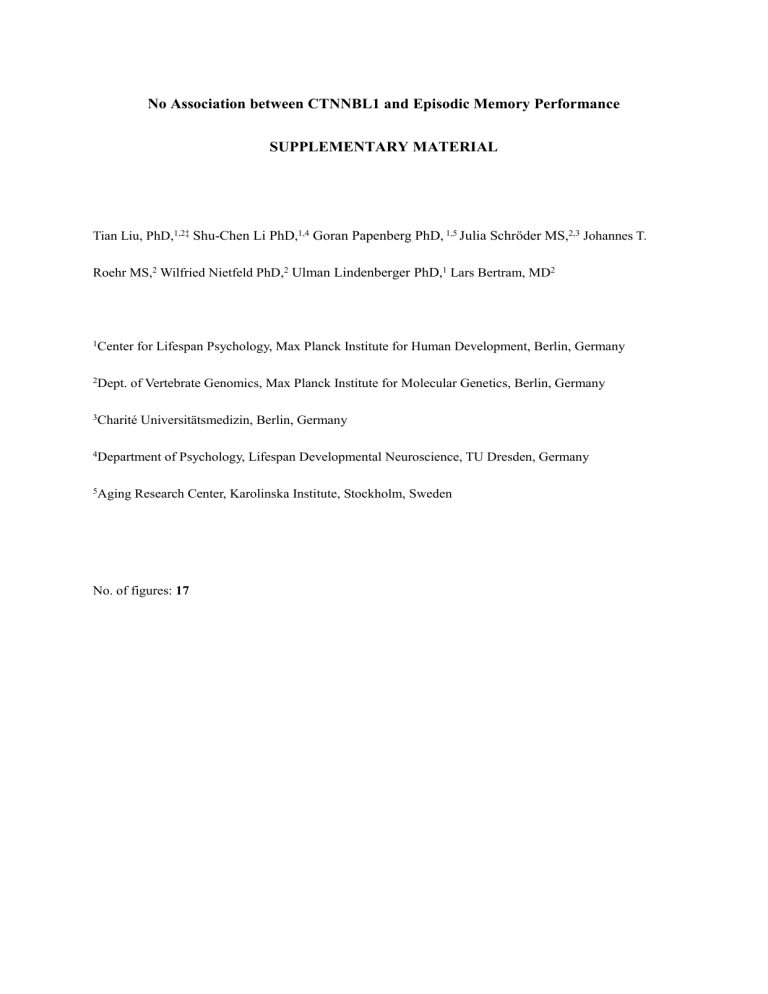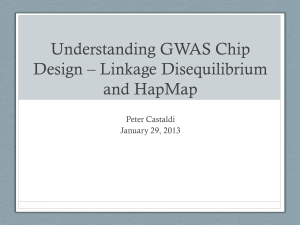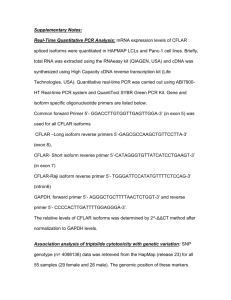Supplementary Information (doc 10014K)

No Association between CTNNBL1 and Episodic Memory Performance
SUPPLEMENTARY MATERIAL
Tian Liu, PhD,
1,2‡
Shu-Chen Li PhD , 1,4 Goran Papenberg PhD , 1,5
Julia Schröder MS,
2,3 Johannes T.
Roehr MS, 2 Wilfried Nietfeld PhD, 2 Ulman Lindenberger PhD , 1 Lars Bertram, MD 2
1 Center for Lifespan Psychology, Max Planck Institute for Human Development, Berlin, Germany
2 Dept. of Vertebrate Genomics, Max Planck Institute for Molecular Genetics, Berlin, Germany
3 Charité Universitätsmedizin, Berlin, Germany
4 Department of Psychology, Lifespan Developmental Neuroscience, TU Dresden, Germany
5 Aging Research Center, Karolinska Institute, Stockholm, Sweden
No. of figures: 17
Supplementary Methods:
FORWARD AND BACKWARD SERIAL-RECALL TASK. In this task, participants were presented with six different lists of 12 words each. The words were presented to the participants auditorially one at a time at a rate of 2 sec/word via headphones, with a number corresponding to each word’s serial position simultaneously presented on a computer screen.
After the presentation of the last item in each list, the participants were asked to recall each word at its correct position. Word Lists 1 to 3 were recalled in forward order (from the first word to the last word of the list), whereas Word Lists 4 to 6 were recalled in backward order
(from the last word to the first word).
Items were German nouns with word length varying from four to nine letters. Words that shared two or more initial letters did not appear in the same list. Recall was self-paced. If participants were unable to recall a word, they could skip that position and move onto the next. After completing a list, participants received feedback about the percentage of correctly remembered words. For each list, responses were scored using a strict serial-recall criterion:
An accurate response required that both the identity of a word and its serial position were correct.
ITEM AND PAIR ASSOCIATIVE EPISODIC MEMORY TASK. The item and pair associative episodic memory task (henceforth labeled as the “item-pair” task) had four conditions that were tested sequentially in one session. During an initial study phase, participants were visually presented with pairs of unrelated words and were instructed to study each pair under two conditions: either as two single words (item instruction) or as a pair of words (pair instruction). In the item instruction condition, an association of word pairs was
learned incidentally, whereas in the pair-instruction condition, it was encoded intentionally.
These two conditions thus differ in their demand on the strategic organization of associative memory during encoding.
Words were German nouns varying from four to nine letters and one to three syllables.
The study phase of each condition contained 30 pairs of semantically unrelated words. Each word pair was presented for 6s. After the study phase, subjects were then required to count a large number backwards in steps of three for 90s to prevent rehearsal and to minimize the influence of short-term memory. Then, the test phase started. In one condition (item recognition), subjects were asked to decide whether or not they had seen the presented word during the study phase. Half of the presented words were old (target items), and the other half was new (distractor items). In the second condition (associative recognition), subjects had to decide whether a presented pair of words had been presented during the study phase or not.
Half of the presented word pairs were old (target pairs), and the others were formed by recombining words in the previously studied lists (repaired distractor pairs).
In the recognition phase, 30 words or word pairs were presented at 4s for each. Taken together, by crossing over the two instruction conditions with the two test conditions, the task resulted in four conditions that assessed item memory (item–item and pair-item tests) and associative memory (pair-pair and item-pair tests). Of particular interest, in terms of the demand of strategic organization of associative memory, the item-item, pair-pair, and item-pair tests varied from no demand to medium and high demand, respectively. As is commonly done in the literature on memory research, recognition memory performance was
measured as hits minus false alarms, in order to minimize the effects of potential individual differences in response bias.
IMAGE RECOGNITION MEMORY WITH RETENTION. Performance in the image recognition memory task was assessed at two retention intervals: 2.5 hours and one week, for each participant. Thus, participants underwent two cognitive testing sessions that were one week apart. At the beginning of the first session, participants were presented with 48 complex, colored images of scenes of neutral emotional valence. The scenes were presented sequentially at a rate of 3s each. All stimuli were derived from the International Affective
Picture System.
The images were encoded incidentally: During the study phase, participants were required to determine whether the scene was “indoor” or “outdoor”—there were 24 scenes in each category—without explicit requirement of memorization. The first retrieval test was administered at the end of the first session after a delay of approximately 2.5 hours after encoding. The second retrieval test was done exactly one week later. During retrieval, participants viewed each image for 3 seconds and were asked to determine whether each scene had been presented (“old”) or not presented (“new) during encoding. In each retrieval test, 24 unique old scenes and 24 unique new scenes (lures) were presented. Taking response bias into account, memory performance was measured as hits minus false alarms
Supplementary Table 1: Summary of cognitive measures / traits across the four tasks tested in CTNNBL1 genetic association analyses in the BASE-II cohort.
Trait Task Description of measures
SRFOBK
SRFO forward and backward serial recall combined forward-backward recall accuracy forward serial recall accuracy of forward recall
SRFO_P1
SRFO_P2
SRFO_P3 forward serial recall forward serial recall forward serial recall accuracy of forward recall primacy portion accuracy of forward recall middle portion accuracy of forward recall recency portion
SRBK
SRBK_P1
SRBK_P2
SRBK_P3 delayed_2.5hour delayed_1week item-item item-pair pair-pair
PC1
PC2
PC3 backward serial recall backward serial recall accuracy of backward recall accuracy of backward recall primacy portion backward serial recall accuracy of backward recall middle portion backward serial recall accuracy of backward recall recency portion image recognition test at retention intervals of 2.5 hours image recognition test at retention intervals of one week proportions of hits minus false alarms proportions of hits minus false alarms item instruction – item test proportion of hits minus false alarms item instruction associative test
– pair instruction – associative test proportion of hits minus false alarms proportion of hits minus false alarms serial recall associative memory delayed image recognition the first principal component of the 14 phenotypes the second principal component of the 14 phenotypes the third principal component of the 14 phenotypes
Supplementary Figure 1 : Local view of association signals in the chromosomal region around CTNNBL1 in: (a) "old”, and (b)"young" BASE-II subjects. In each panel, SNPs are plotted by position on the chromosome against association with “SRFOBK” (–log10 P). The index SNP rs16986890 is denoted by a purple circle, and the location of gene CTNNBL1 is highlighted with grey below the plots. SNPs are colored to reflect linkage disequilibrium (LD) with rs16986890 (using the CEU panel from HapMap Phase II). Images were generated using a)
LocusZoom b)
Supplementary Figure 2 : Local view of association signals in the chromosomal region around CTNNBL1 in: (a) "old”, and (b)"young" BASE-II subjects. In each panel, SNPs are plotted by position on the chromosome against association with “SRFO” (–log10 P). The index SNP rs16986890 is denoted by a purple circle, and the location of gene CTNNBL1 is highlighted with grey below the plots. SNPs are colored to reflect linkage disequilibrium (LD) with rs16986890 (using the CEU panel from HapMap Phase II). Images were generated using a)
LocusZoom b)
Supplementary Figure 3 : Local view of association signals in the chromosomal region around CTNNBL1 in: (a) "old”, and (b)"young" BASE-II subjects. In each panel, SNPs are plotted by position on the chromosome against association with “SRFO_P1” (–log10 P). The index SNP rs16986890 is denoted by a purple circle, and the location of gene CTNNBL1 is highlighted with grey below the plots. SNPs are colored to reflect linkage disequilibrium (LD) with rs16986890 (using the CEU panel from HapMap Phase II). Images were generated using a)
LocusZoom b)
Supplementary Figure 4 : Local view of association signals in the chromosomal region around CTNNBL1 in: (a) "old”, and (b)"young" BASE-II subjects. In each panel, SNPs are plotted by position on the chromosome against association with “SRFO_P2” (–log10 P). The index SNP rs16986890 is denoted by a purple circle, and the location of gene CTNNBL1 is highlighted with grey below the plots. SNPs are colored to reflect linkage disequilibrium (LD) with rs16986890 (using the CEU panel from HapMap Phase II). Images were generated using a)
LocusZoom b)
a)
Supplementary Figure 5 : Local view of association signals in the chromosomal region around CTNNBL1 in: (a) "old”, and (b)"young" BASE-II subjects. In each panel, SNPs are plotted by position on the chromosome against association with “SRFO_P3” (–log10 P). The index SNP rs16986890 is denoted by a purple circle, and the location of gene CTNNBL1 is highlighted with grey below the plots. SNPs are colored to reflect linkage disequilibrium (LD) with rs16986890 (using the CEU panel from HapMap Phase II). Images were generated using
LocusZoom b)
Supplementary Figure 6 : Local view of association signals in the chromosomal region around CTNNBL1 in: (a) "old”, and (b)"young" BASE-II subjects. In each panel, SNPs are plotted by position on the chromosome against association with “SRBK” (–log10 P). The index SNP rs16986890 is denoted by a purple circle, and the location of gene CTNNBL1 is highlighted with grey below the plots. SNPs are colored to reflect linkage disequilibrium (LD) with rs16986890 (using the CEU panel from HapMap Phase II). Images were generated using a)
LocusZoom b)
Supplementary Figure 7 : Local view of association signals in the chromosomal region around CTNNBL1 in: (a) "old”, and (b)"young" BASE-II subjects. In each panel, SNPs are plotted by position on the chromosome against association with “SRBK_P1” (–log10 P). The index SNP rs16986890 is denoted by a purple circle, and the location of gene CTNNBL1 is highlighted with grey below the plots. SNPs are colored to reflect linkage disequilibrium (LD) with rs16986890 (using the CEU panel from HapMap Phase II). Images were generated using a)
LocusZoom b)
Supplementary Figure 8 : Local view of association signals in the chromosomal region around CTNNBL1 in: (a) "old”, and (b)"young" BASE-II subjects. In each panel, SNPs are plotted by position on the chromosome against association with “SRBK_P2” (–log10 P). The index SNP rs16986890 is denoted by a purple circle, and the location of gene CTNNBL1 is highlighted with grey below the plots. SNPs are colored to reflect linkage disequilibrium (LD) with rs16986890 (using the CEU panel from HapMap Phase II). Images were generated using a)
LocusZoom b)
Supplementary Figure 9 : Local view of association signals in the chromosomal region around CTNNBL1 in: (a) "old”, and (b)"young" BASE-II subjects. In each panel, SNPs are plotted by position on the chromosome against association with “SRFO_P3” (–log10 P). The index SNP rs16986890 is denoted by a purple circle, and the location of gene CTNNBL1 is highlighted with grey below the plots. SNPs are colored to reflect linkage disequilibrium (LD) with rs16986890 (using the CEU panel from HapMap Phase II). Images were generated using a)
LocusZoom b)
Supplementary Figure 10 : Local view of association signals in the chromosomal region around CTNNBL1 in: (a) "old”, and (b)"young" BASE-II subjects. In each panel, SNPs are plotted by position on the chromosome against association with “item-item” (–log10 P). The index SNP rs16986890 is denoted by a purple circle, and the location of gene CTNNBL1 is highlighted with grey below the plots. SNPs are colored to reflect linkage disequilibrium (LD) with rs16986890 (using the CEU panel from HapMap Phase II). Images were generated using a)
LocusZoom b)
Supplementary Figure 11 : Local view of association signals in the chromosomal region around CTNNBL1 in: (a) "old”, and (b)"young" BASE-II subjects. In each panel, SNPs are plotted by position on the chromosome against association with “item-pair” (–log10 P). The index SNP rs16986890 is denoted by a purple circle, and the location of gene CTNNBL1 is highlighted with grey below the plots. SNPs are colored to reflect linkage disequilibrium (LD) with rs16986890 (using the CEU panel from HapMap Phase II). Images were generated using a)
LocusZoom b)
Supplementary Figure 12 : Local view of association signals in the chromosomal region around CTNNBL1 in: (a) "old”, and (b)"young" BASE-II subjects. In each panel, SNPs are plotted by position on the chromosome against association with “pair-pair” (–log10 P). The index SNP rs16986890 is denoted by a purple circle, and the location of gene CTNNBL1 is highlighted with grey below the plots. SNPs are colored to reflect linkage disequilibrium (LD) with rs16986890 (using the CEU panel from HapMap Phase II). Images were generated using a)
LocusZoom b)
Supplementary Figure 13 : Local view of association signals in the chromosomal region around CTNNBL1 in: (a) "old”, and (b)"young" BASE-II subjects. In each panel, SNPs are plotted by position on the chromosome against association with “delay_2.5hour” (–log10 P).
The index SNP rs16986890 is denoted by a purple circle, and the location of gene
CTNNBL1 is highlighted with grey below the plots. SNPs are colored to reflect linkage disequilibrium (LD) with rs16986890 (using the CEU panel from HapMap Phase II). Images a) were generated using LocusZoom b)
Supplementary Figure 14 : Local view of association signals in the chromosomal region around CTNNBL1 in: (a) "old”, and (b)"young" BASE-II subjects. In each panel, SNPs are plotted by position on the chromosome against association with “delay_1week” (–log10 P).
The index SNP rs16986890 is denoted by a purple circle, and the location of gene
CTNNBL1 is highlighted with grey below the plots. SNPs are colored to reflect linkage disequilibrium (LD) with rs16986890 (using the CEU panel from HapMap Phase II). Images a) were generated using LocusZoom b)
a)
Supplementary Figure 15 : Local view of association signals in the chromosomal region around CTNNBL1 in: (a) "old”, and (b)"young" BASE-II subjects. In each panel, SNPs are plotted by position on the chromosome against association with “PC1” (–log10 P). The index
SNP rs16986890 is denoted by a purple circle, and the location of gene CTNNBL1 is highlighted with grey below the plots. SNPs are colored to reflect linkage disequilibrium (LD) with rs16986890 (using the CEU panel from HapMap Phase II). Images were generated using
LocusZoom b)
a)
Supplementary Figure 16 : Local view of association signals in the chromosomal region around CTNNBL1 in: (a) "old”, and (b)"young" BASE-II subjects. In each panel, SNPs are plotted by position on the chromosome against association with “PC2” (–log10 P). The index
SNP rs16986890 is denoted by a purple circle, and the location of gene CTNNBL1 is highlighted with grey below the plots. SNPs are colored to reflect linkage disequilibrium (LD) with rs16986890 (using the CEU panel from HapMap Phase II). Images were generated using
LocusZoom b)
a)
Supplementary Figure 17 : Local view of association signals in the chromosomal region around CTNNBL1 in: (a) "old”, and (b)"young" BASE-II subjects. In each panel, SNPs are plotted by position on the chromosome against association with “PC3” (–log10 P). The index
SNP rs16986890 is denoted by a purple circle, and the location of gene CTNNBL1 is highlighted with grey below the plots. SNPs are colored to reflect linkage disequilibrium (LD) with rs16986890 (using the CEU panel from HapMap Phase II). Images were generated using
LocusZoom b)






